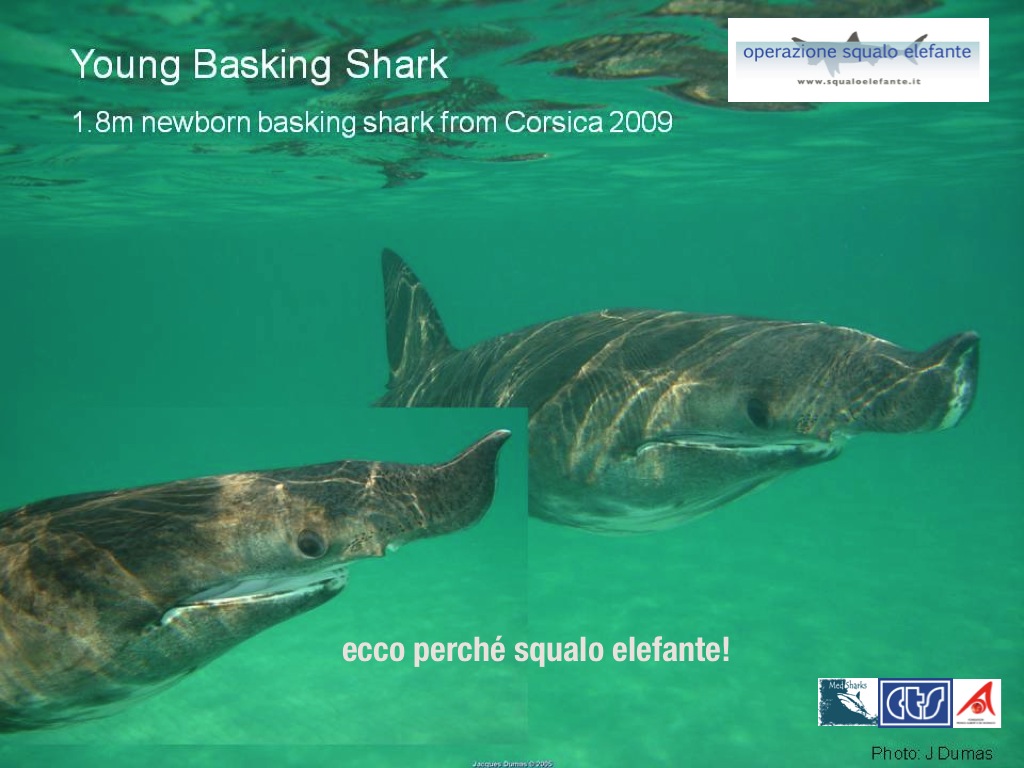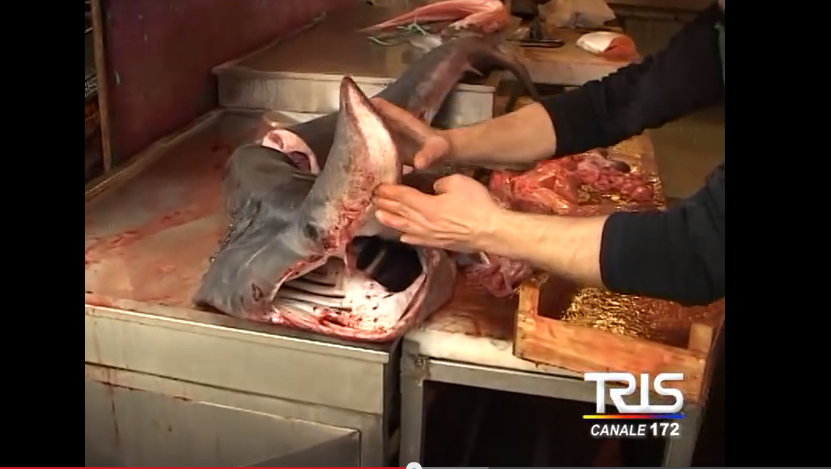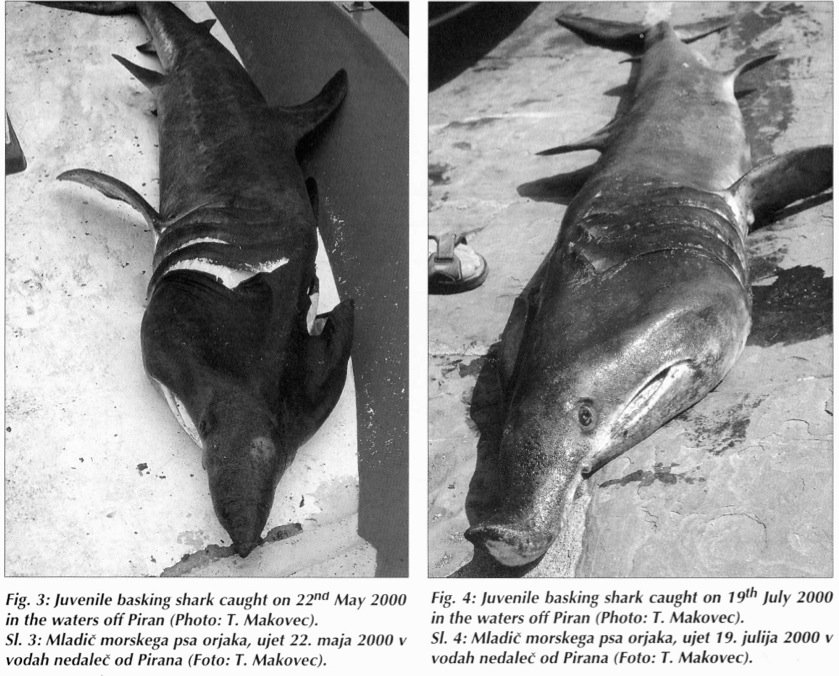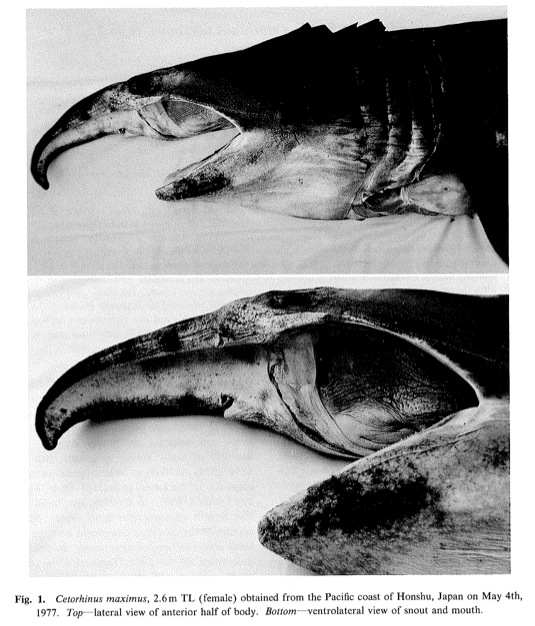| Photo/#/Date/Location | Reference | Sex | TL (m) & Condition Factor |
W (kg) | PCL (m) | Comments |
|---|---|---|---|---|---|---|
| The condition factor (CF) = Mass (kg)/TL(m)^3 is a good indicator to catch outliers w.r.t. mass or total length. From Zouffa et al (2001) entry: Table 1 summarizes basing shark records in the Atriatic Sea for 2000-2001. Length and mass is given for 5 sharks with condition factor (CF = M/TL^3) of 4.5, 5.8, 4.1, 4.5, and 4.1. Mean CF was 4.6 kg/m^3. From Mass-TL equation given in Natanson & Wintner et al (2008) the following CF's were calculated : For TL = 2.5, 5.0, 7.5, and 10.0 m, CF = 6.5, 6.2, 6.05, and 5.9, respectively. For basking sharks in TL range 2.5 - 10.0 m , CF is expected to be around 6. | ||||||
| #001/<1769 | Sund (1943) | ? | 0.3; embryo | "Very little is known about the reproduction of this shark. The only information I have found in the literature is published in the book "Northern fishes" (article from Pennant[1769]) which says that one embryo of 30 cm has been found." | ||
| #002/1888/Camogli, Liguria, Italy | Barrul , J. & I. Mate (1999) | ? | 1.5 | Barrul , J. & I. Mate (1999, # 18 in Table 1 comprising 165 specimens. Ref is Carruccio (1906). | ||
#003/May 1913/ Porto Paglia, Sardinia, Italy |
Barrul , J. & I. Mate (1999) | ? | ~1.5; free-swimmer | Barrul , J. & I. Mate (1999, #41 in Table 1 comprising 165 specimens). Ref is Ariola (1913). Natador libre = free-swimmer. Also mentioned in Moreno (1995). Page 14 in Ariola (1913) in footnote mentions a specimen that was caught in May 1913 in Porto Paglia (Sardinia) in a small tuna trap. It measured about 1.5 m. (E. de Sabata pers. comm.). As it was caught in a 'tonnara' it must have been a free-swimmer. |
||
#004/Late Aug, 1936/N-NW of Geitmare, Norway |
Sund (1943) | ? | ~ 1.5 - 2.0; embryos/neonates |
"It was only one basking shark baby that I caught and it was about one and a half meter long. It did not have a yolk sac nor umbilical cord. The front of the snout was narrow with a little curve on the underside (upperside?). It had 8 litres of liver. It came swimming with an open mouth as they do when they gather the food. The length information is somewhat arbitrary. A reasonable length should have been about 1.5 m, perhaps 2 m, as the 'common porbeagle shark' is usually over 2 m." | ||
 #005/2005/Off Peel, Isle of Man |
Manx Marine Environmental Assessment (Oct 2013) | ~ 1.6 | Newborn and young basking sharks in Manx waters. Many young basking sharks are seen in Manx waters. Based on public sighting data, more small basking sharks of 1.5m-2.0m are seen in Manx waters than are recorded in the whole of the rest of the British Isles (Hall et al 2009). Sharks of this size are thought to be newly born. Figure 18 shows a newborn basking shark photographed in Manx waters. This very small ‘newborn’ basking shark of approximately 1.6m length was surface feeding with a group of mature individuals. It had also been seen curled up in a ‘C’ shape on the surface the day before. It seems likely that it is a very young individual. The pig-like snub nose is quite different to that of mature individuals. It is thought that it is an adaptation to inter-uterine feeding behaviour before birth. |
|||
 #006/July/? |
Matthews (1950) | ? | 1.651 5 ft 5 in free-swimmer? |
Matthews (1950, #2 in Fig. 24, see Photo; Ref given is Day 1880-4). Probably a free-swimmer but have not seen Day 1880-4 . Probably same as 5 ft 5 in (1.65 m) specimen in Bigelow & Schroeder (1948) who gives Thompson (1856) Nat. Hist. Ireland, 4:253 as ref. Also mentioned by Compagno (1985) giving Bigelow & Schroeder (1948) as ref. Probably same specimen listet by Parker and Stott (1965, see below) but reporting incorrect length. Matthews proposed that the 2 smallest fish mentioned are in the same age class as 3 fish of length 2.74-3.37 m. I suggest these fish are at least one yr older. | ||
| #006/July 1849, Lough Swilly, Ireland | Parker and Stott (1965) | ? | 1.68 but should have been 1.651 (5 ft 5 in)? | Original ref is Thompson (1856) acc. to Parker and Stott (1965). Must be the same specimen mentioned by Matthews (1950). " It seems unlikely that this fish (and 1.8 m Casablanca fish below) are in the same age class as the summer-caught fish of between 2.54 - 3.44 m". I agree with this assessment. Their growth curve in Fig. 2 is more reaonable than the one presented by Matthews (1950) but growth may still be too large. | ||
| #007/May 1955, Casablanca | Furnestin (1958) | ? | 1.8 | Original ref is Furnestin (1958) acc to Parker and Stolt (1965). . " It seems unlikely that this fish (and 1.68 m fish above) are in the same age class as the summer-caught fish of between 2.54 - 3.44 m". Also mentioned by Izawa and Shibat (1993) | ||
| E. de Sabata pers. comm. | ? | 1.8 | Photographer J. Dumas said: The young shark was in the Saint Florent Bay, Corsica in no more than 4 m of water near the beach. I took the pictures in apnea (1 hour of very exciting swimming together). The shark first maintained a distance but after 10 minutes he accepted my presence and I started to get more and more pictures swimming and maybe playing together. My length estimation was about 1.80 m. It could be +- 20 - 40 cm because I was swimming besides not below. |
|||
| Matthews (1950) | ? | ~1.83 6 ft Foetus |
Matthews (1950, #1 in Fig 24, see Photo). Refs are Watkins (1948) who observed that none smaller than 6 ft were seen in fishery at Carradale, Argyllshire AND anonymous fisherman who observed ~6 ft foetus in a pregnant fish. | |||
| #010/ | Hasse (1882) | ~1.83 6 ft |
This specimen had 6 band-pairs acc. to Natanson & Wintner et al. (2008). the same number as the 2.61 m specimen from Durban SA below. I suggest the # of band pairs cannot be used to estimate the age class of young basking sharks as was done by Izawa and Shibata (1993). | |||
 #011/23 July 2012/Belgium |
Frederik H. Mollen, pers. comm. | < 2 m | http://www.natuurbericht.be/?id=8829; |
|||
| #012/June-July 1927/Ognina, Siracusa, Sicily | Barrul , J. & I. Mate (1999) | F | 2.0 | Barrul , J. & I. Mate (1999, # 63 in Table 1). Ref is Monterosso (1931). | ||
| #013/June-July 1928/Ognina, Siracusa, Sicily | Barrul , J. & I. Mate (1999) | F | 2.0 | Barrul , J. & I. Mate (1999, # 66 in Table 1. Ref is Monterosso (1931). | ||
| #014/10 Apr 1942/Ciutat de Palma, Mallorca | Barrul , J. & I. Mate (1999) | ? | 2.0 | Barrul , J. & I. Mate (1999, # 81 in Table 1). Ref is Navorra (1943). | ||
 #14b/Dec 2014/Slovenia |
E. de Sabata pers. comm. | 2.0 | Il blog dell'Operazione Squalo Elefante: It was caught accidentally in the net of a Slovenian fisherman in late December and was later taken to the Natural History Museum in Lubjana, which we contacted for more information and samples to use in our studies. The news was originally published on the Trieste daily il Piccolo. | |||
| E. de Sabata pers. comm. | 2.3 | Measured by a veterinarian in Siracusa, Sicily; the shark was caught in a tremmel net https://www.youtube.com/watch?v=RHKGxtmttzw&feature=youtu.be |
||||
| Libej et al (2000) | M | 2.49 CF ~ 4.5 |
~70 kg |
1.95 (78.3%) |
Libej et al (2000, Fig. 4 on right in Photo). Characterized as young-of-the year in Salso and Jardas (2008. p. 107). | |
#017/07 Dec 1968/Ston, Croatia |
Salso and Jardas (2002) | ? | 2.50 CF ~ 5.1 |
80 |
Salso and Jardas (2002, Refs 50 & 55). | |
| #018 | Pengelly (1981) | 2.54 | Pengelly (1881) is given in Bigelow and Schroeder (1948) and Izawa and Shibata (1993). | |||
| Izawa and Shibata (1993) | F | 2.600 | 2.045 (78.7%) | Isawa and Shibata (1993). Estimated age to be less than 6 month based on # of calcified rings in the verebral centra. This coud be questioned in view of Natanson et al (2008, Fig.7). They report that Parker & Bosemann (1954) suggested that length at birth is 1.8 m and then growth is at a rate of 0.2 m/mo for 6-8 months (would be 2.4 m/y) and diminishing to 0.06 m/mo by the end of the 5th year (would be 0.72 m/y). Paper includes a complete set of morphometrics for this 2.600 m specimen. For end of Table 1 download PDF of paper in Reference column. |
||
| #020 | 2.6 | Biegelow & Schroeder (1948) acc. to Izawa and Shibata (1993).. Check if not same specimen as above. | ||||
| #021/15 July 2001/Salt Rock, 45 km north of Durban, South Africa | Natanson et al (2008) | 2.61 CF ~ 2.7 |
48 |
2.05 (78.5%) | 6 band pairs acc. to Fig. 7 in Natanon et al. (2008). This specimen was far away from "home turf" which may explain its apparently emaciated condition (Geremy Cliff posting to elasmo-l on July 16, 2001) | |
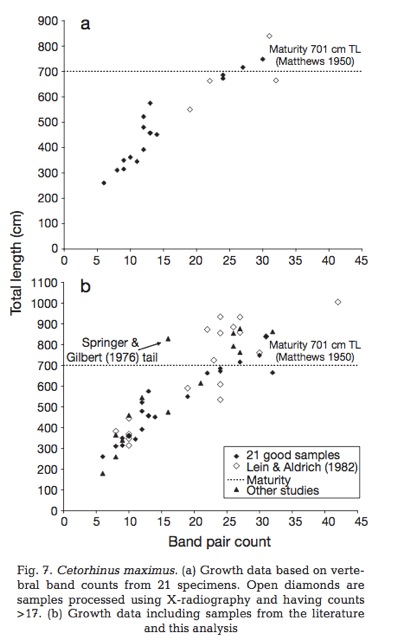 |
Natanson et al (2008) | 2.61-8.56 | Vertebrae were obtained from 40 specimens: 13 females (261 to 856 cm), 16 males (311 to 840 cm) and 11 specimens of unknown sex (376 to 853 cm) (Table 1). |
|||
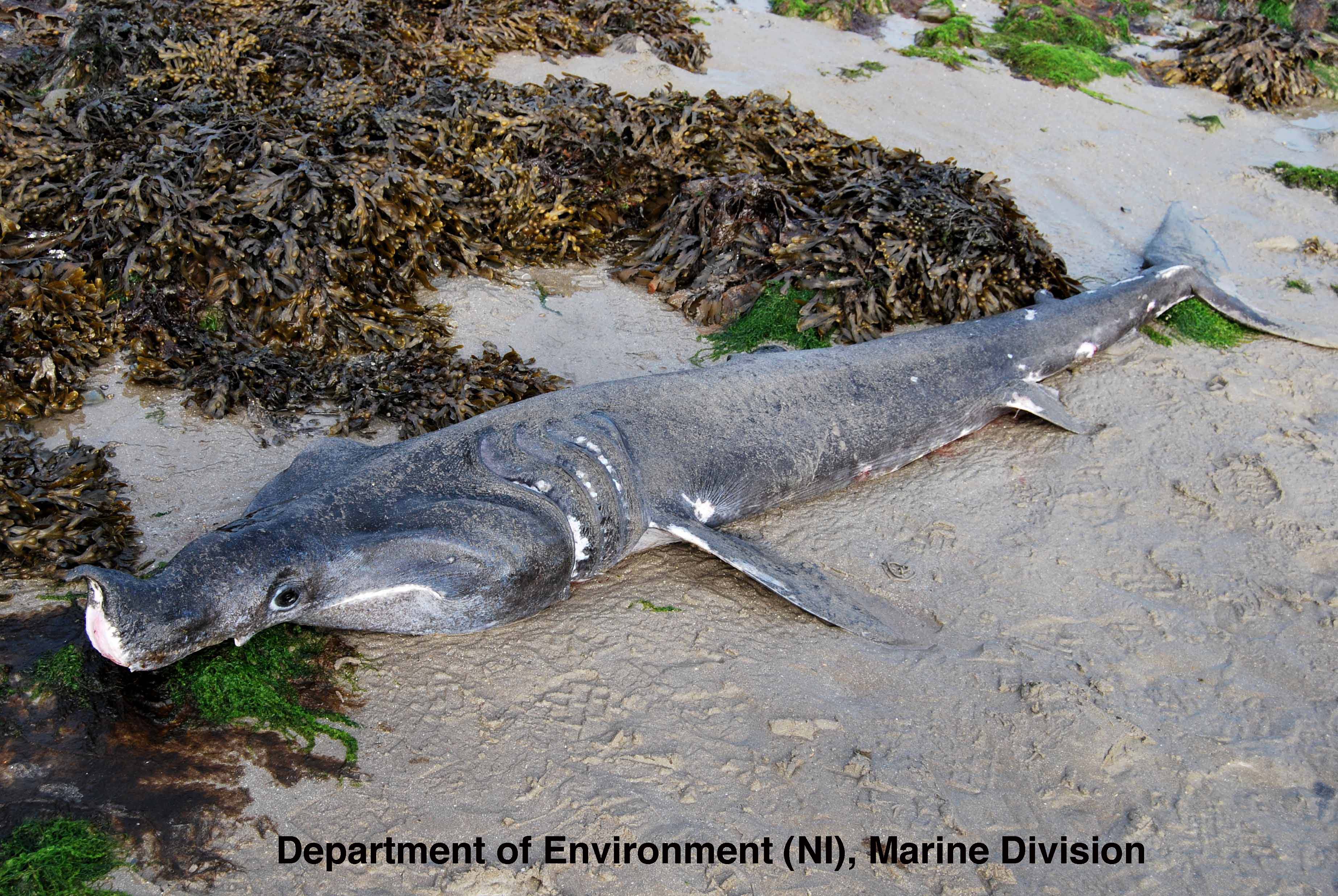 #022/23 Sep 2014; Millisle, Co. Down, N Ireland |
G. Burrows pers. comm. | M | 2.63, young juvenile CF ~ 1.9 |
34 |
Stranded alive on 23rd September 2014 at Millisle, Co. Down, N Ireland. Carcass recovered on 24th September for post mortem by Agri-Food and Bioscience Institute. Post mortem found no significant abnormalities and no evidence of sustained feeding or plankton. Carcass will be preserved and displayed at the Portrush Coastal Zone, with tissue samples provided to research community under licence. In Northern Ireland, the basking shark is protected under the Wildlife (NI) Order. Another picture of head. |
|
| #023/18 Jun 1986/Icici, Croatia | Saldo and Jardas (2002) | ? | 2.65 CF ~ 6.6 |
120 |
Salso and Jardas (2002). Refs 11 & 45. | |
 #024/June 1870/Mounts Bay |
Matthews (1950) | 2.74 |
Matthews (1950, #3 in Fig. 24, see Photo; Ref given is Day 1880-4). Matthews proposed that this specimen was also a young-of-the-year and assigned an age of ~ 0.5 y, same as the 5 ft 5 in free-swimmer in June and the ~ 6 ft foetus mentioned above. I suggest that this shark and also #s 4& 5 were at least one year older. | |||
#025 |
Zuffa et al. (2001) | 2.49-12 | 70-2500 (for 8.5 m spec) | Table 1 summarizes basing shark records in the Atriatic Sea for 2000-2001. Length and mass is given for 5 sharks with condition factor (CF = M/TL^3) of 4.5, 5.8, 4.1, 4.5, and 4.1. Mean CF is 4.6 kg/m^3. | ||
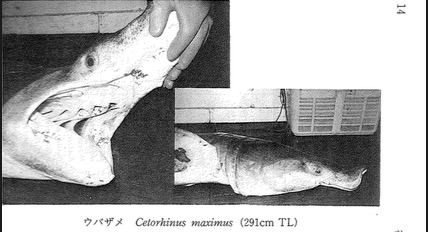 #025b/Jan 1986/near Louisville Seamount Chain (37oS, 171oW) |
Yatsu (1995) from M. Francis | 2.91 | Translation of Fig 21 caption by Shelley Clarke (relevant parts): |
|||
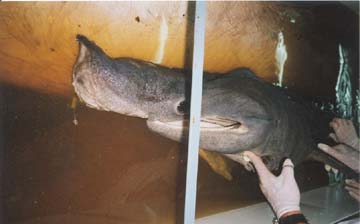 #026/ |
C. Stenberg pers. comm. | M | 2.92 CF ~3.6 |
~90 | Slideshow
of 2.92 m TL male juvenile basking shark caught in Porto Moniz (North-West
coast of Madeira), on 29 Jan 2000 Approximately 90 kg (we didn't have a scale, CF ~ 3.6); gonads 0.386 kg (GSI ~ 0.43%); liver 4.570 kg (HSI ~5%). Thanks to Charlott Stenberg. |
|
| Libej et al (2000) | M | 2.99 CF ~ 4.5 |
~ 120 |
2.36 (78.9%) |
Libej et al (2000, Fig. 3 see Photo). Has morphometircs in Table 1. | |
| 1986-1999 | Francis and Duffy (2002) | 3.5-5.0 |
1500 - 2000 | A catch of 7 was supported by individual length (3.5-5.0 m) and mass estimated (1.5-2.0 t). Condition factor using lower and upper limits of length and mass range, respectively, yields 35.0 - 16.0. It suggests that mass or length estimate are suspect in view of CF that I caluclated from data given in Zuffa et al. (2001). |
||
| <1974 | Ryan (1974) | 5.0 | Quoting from Francis and Duffy (2002): "Ryan (1994) reported a 5 m basking shark from Lake Ellesmere, a large, shallow brackish lake south fo Banks Peninsula, South Island New Zealand and in Sep 1979, multiple sharks were observed in the same lake over a 1 week period, including 21 individuals on a single day (Dodgeshun 1980)." | |||
| 1986-1999 | Francis and Duffy (2002) | 8 M, 6F | 4.0-6.5 | Greatest number (14) in one commercial tow from scientific observer record. | ||
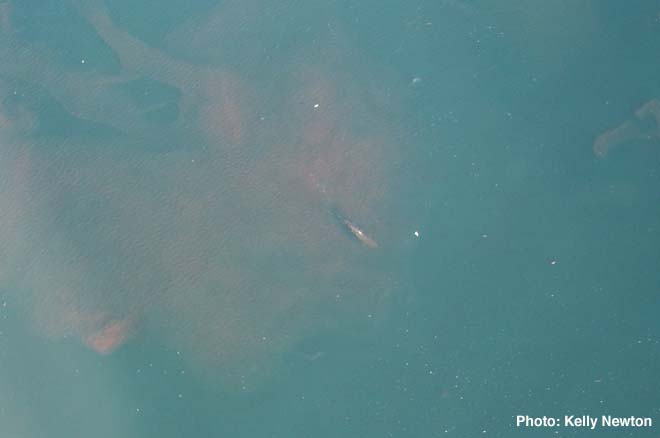 02 Sep 2002 |
Kelly Newton pers. comm. | Most recent basking shark sighting in Monterey Bay, Kelly Newton took the attached picture on Monday (02 Sep 2002) out in Monterey Bay. Along with the Basking Shark there were 4-5 blue whales and 2 humpback whales. From the plane (650 ft.) we could see it with its mouth open cruising through all of the krill. | ||||
 23 Mar 2016 |
Victor Lin |
6 CF > 4.6 |
>1000 | 6m, over 1 tonne basking shark was caught in a set net at Yokosuka, Kanagawa on 29th of March. Source URL | ||
| Fahmia and W.T. White (2015). | M | 6.7 | Fahmia and W.T. White (2015). Marine Biodiversity Records / Volume 8 / 2015, e18 (3 pages). First record of the basking shark Cetorhinus maximus (Lamniformes: Cetorhinidae) in Indonesia. |
|||
 08 Aug 2007 |
posting to Elasmo-l by Sonja Fordham; additional information from Frederik Mollen | F | 6.86 TOT (stretched); |
1800 gutted; could not be verified | 5.52 | The Shark Alliance was on the scene for today's fish market display of a six meter, two-ton, female basking shark, landed illegally last night in Zeebrugge, Belgium. The shark was reportedly taken unintentionally by Belgian trawlers fishing in the Celtic Sea. |
| <1950 | Matthews (1950) | M | 6.8 | In north-eastern Atlantic, Matthews (1950) and Matthews and Parker (1950) observed a 6.8 m, maturing male basking shark, and mature males of 7.6--8.1 m "in vigorous sexual activity" according to Francis and Duffy (2002). | ||
05 Oct 2000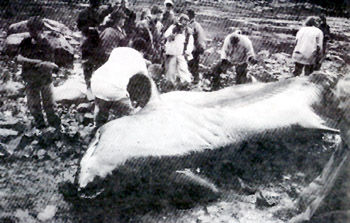 |
Victor Lin p.c. | 7.4 | Found by Victor Lin on Web. 24' 4'' basking shark washed up on the Edmonds side of the Dennys river, Maine USA. | |||
 <1950 |
Matthews (1950) | M | 7.8-8.1 | In north-eastern Atlantic, Matthews (1950) and Matthews and Parker (1950) observed a 6.8 m, maturing male basking shark, and mature males of 7.6--8.1 m "in vigorous sexual activity" according to Francis and Duffy (2002). | ||
|
Francis and Duffy (2002) | 7-8 | Two commercial bottom trawlers caught 32 basking sharks on the seabed in depths of 200-300 m off Hawke Bay New Zealand. None were caught in the 10 years before and the year after. | |||
| <1950 | Matthews (1950) | F | 7.7-8.2 | Matthews (1950) and Matthews and Parker (1950) considered five females of 7.7-8.2 m to be mature according to Francis and Duffy (2002). | ||
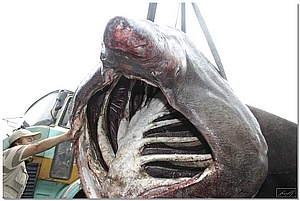 5 May 2005; Hualien, Eastern Taiwan |
Shih-Chu Yang and John Y. Wang pers. comm. | M | >8 | They got a > 8m long male basking shark - sold and gone. Measurements and samples for DNA were taken by Sichu. Thanks for information to Shih-Chu Yang and John Y. Wang. | ||
| <1931 | Biegelow & Schroeder (1948) | 8.534 (~28 ft) CF ~ 4.8 |
Monteerey Bay specimen reported in McGiniti (1931) Science N.S. 73:496 | |||
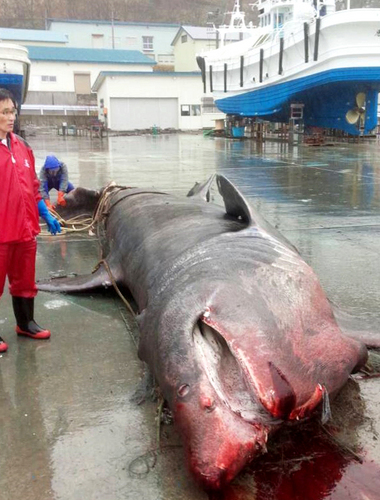 01 Dec 2014 |
Victor Lin pers. comm. | M | 8.79 | A large, measuring 8.79m basking shark was caught by a gill net in Rausu, Hokkaido, Japan on 1st December. News available at: http://mainichi.jp/select/news/20141203k0000m040075000c.html (in Japanese).. Acc. to Victor only 1 or 2 are captured each year near Rausu. |
||
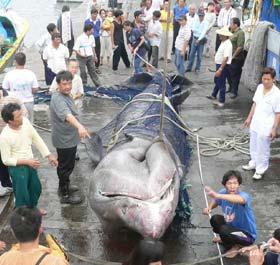 5 May, 2005 |
Victor Lin pers. comm. | M | 8.92 CF ~ 5.2 |
3700 | They got a > 8m long male basking shark - sold and gone. Measurements and samples for DNA were taken by Sichu. Thanks for information to Shih-Chu Yang and John Y. Wang. Check if not same as above +2. | |
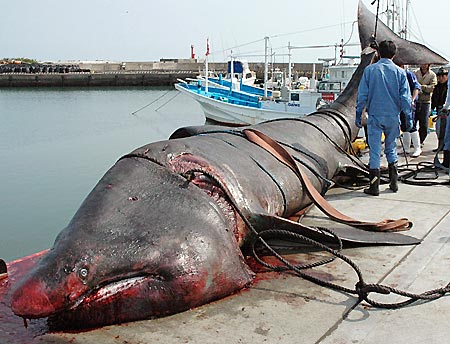 April 2007 |
Victor Lin pers. comm. | 9 CF ~ 6.3 |
4600 | April 2007. Victor Lin saw on a Chinese website that Japanese fishermen caught a 9 meter, 4.6 ton basking shark. According to the news, it was the largest ever caught off Japan. | ||
| <1931 | Biegelow & Schroeder (1948) | 9.068 CF ~ 5.2 |
3901 | Monterey Bay specimen reported in McGiniti (1931) Science N.S. 73:496 to be a few inches less than 30 ft long | ||
| 1889; New Zealand |
Cheeseman (1891) | 10.43 | Earliest published record of a basking shark caught in north-eastern New Zealand (36deg39'S, 174deg45'E) in 1889 according to Francis and Duffy (2002). | |||
| 15 Mar 2001 | Zuffa et al. (2001) | 10-12 | Group of some 10 specimens were sighted 12-13 miles off the coast. Harbour Office representative approached and photographed one individual. | |||
| 06 Aug 1851 | Evan Hodder pers. comm. | 12.22 | The largest reliably recorded basking shark probably an individual measuring 40ft 3in that was caught on August 6, 1851 in Musquash Harbor, Bay of Fundy, New Brunswick, Canada. | |||
| 1931 | Tomas (2004) | 9.5 assuming CF = 4.6 | ~3900 | Caught by fisherman Thomas Machado in Monterey Bay in 1931. This "Basker" weighed 8600 lbs, including a liver weighing 2100 lbs (24.4%). | ||
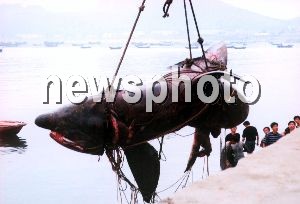 16 Aug 2001; Daliang, N.E. China |
Victor Lin pers. comm. | 4000 | A 4000 kg basking shark caught at Daliang, N.E. China on 2001 Aug 16. | |||
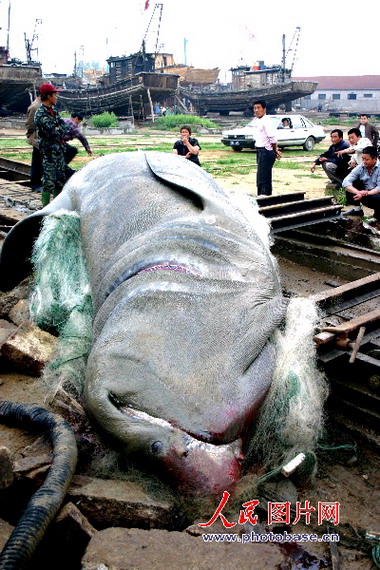 23 May 2007 |
Victor Lin pers. comm. | ~10 CF ~ 5.0 |
~5000 | Five-ton
blue shark captured in east China | ||
| 21 Oct. 2004; Taiwan |
Victor Lin pers. comm. | ~15? 11.0 assuming CF = 4.6 |
6200 | The news was reported to Victor Lin by a local fish dealer who called him the next day and said the bigger basking was about 6 tons. Victor then searched on the internet and found a brief account in a local newspapers that claimed the shark was 15 meters long and weighed 6 tons. They also reported that the shark was soon gutted and cut into pieces and no photo was available. The jaw of the shark was saved by a graduate student at a local university. | ||
after 1948; |
Tomas (2004) | 11.1 assuming CF=4.6 | ~6350 | Had largest liver (3500 lbs = 1588 kg) ever for a basking shark caught in Monterey Bay. Harpooned by Moss Landing fisherman Freeman "Whitey". Assuming liver was 25% of body mass, then this basking shark weighed about 6350 kg. | ||
| <2001 | 12.2-15.2 | Compagno (2001, FAO cat.): "Basking sharks have been credited as reaching a maximum total length of 12.2 to 15.2 m, but even if this is correct, most specimens do not exceed approximately 9.8 m." | ||||
| 1851/New Bruinswick, Canada | McClain et al. (2015) | 12.27 | The largest specimen ever recorded was 12.27 m, and was entangled in a herring net on August 6, 1851 in Musquash Harbor, Bay of Fundy, New Brunswick, Canada (Carwardine, 1995). | |||
| Photo/Date/Location | Reference | Sex | TL (m) | W (kg) | FL (m) | Comments |
